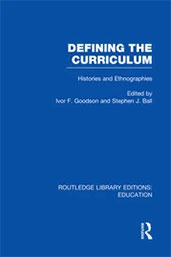Defining the Curriculum: histories and ethnographies
Subjects for Study: towards a social history of curriculum
The tendency to fragmentation in geography through the proliferation of sub-groups and sub-versions is a recurrent feature of the subject's history, and was echoed by the Norwood Report's (1943) fear about the' expansiveness of geography'. At this earlier stage, they saw geography as 'the study of man and his environment from selected points of view' - a definition at that time leading to fears that through its expansiveness geography was becoming 'a "world citizenship" subject, with the citizens detached from their physical environment' (pp. 101-2). As a result 'by then, geography had become grievously out of balance; the geographical synthesis had been abandoned.' The problem was fairly rapidly addressed and a decade later Garnett claimed that most departments were headed by specialists so that 'the initial marked differences and contrasts in subject personality had been blurred or obliterated' (Garnett, 1969, p. 368).
The means by which the fragmentary sub-groups were monitored, controlled and periodically unified will be dealt with later. However, in the period of the battle over 'environmental education', two, or more accurately three, major sub-groups within the subject were actively concerned: the regional geographers, the field geographers and, the fastest-growing subgroup, the 'new' geographers. The first two groups, representing strong traditions within the subject had large support among school geography teachers. The latter group was largely derived from new developments in the subject within the universities. The first two sub-groups were considerably more sympathetic to environmental initiatives than the new geographers. This was because the environmental lobby offered aid and sustenance to the field and regional geographers. Hence, we find eminent regional geographers like Professor Bryan promoting conferences in environmental studies because this expressed more clearly than new geography 'his own life's work and ambitions as a geographer' (Millward, 1969, p. 93). Thomas explained the affection for environmental approaches entirely in terms of the struggle for survival of the regional sub-group (Thomas, 1970, pp. 274-5), and a college lecturer in geography judged that the new crisis among geography sub-groups 'caused traditional [regional and field] geographers to flee into environmental studies for a time' (interview, Scraptoft, 14 December 1976). This flirtation proved a short term phenomenon because of the overwhelming desire for fully-fledged academic status among all geographers; because new geography carried within it the seeds of this final acceptance; and because the activities of the Geographical Association and the university schools of geography together helped direct and manage the change towards a new 'geographical synthesis' where once again the sub-groups were 'delicately held together'.
The pattern discerned among geography sub-groups in the period of environmental education's emergence is partly echoed when considering biology. Again the subject began with a variety of idiosyncratic versions and groupings devised and taught by specialists from other disciplines, in botany and zoology. By the 1960s biology had also developed a major sub-group whose concern with ecology and field biology bordered on the new environmental approaches. For a time this sub-group gained considerable momentum from initiatives like the Keele Conference which saw this version of biology as promoting environmental awareness.
